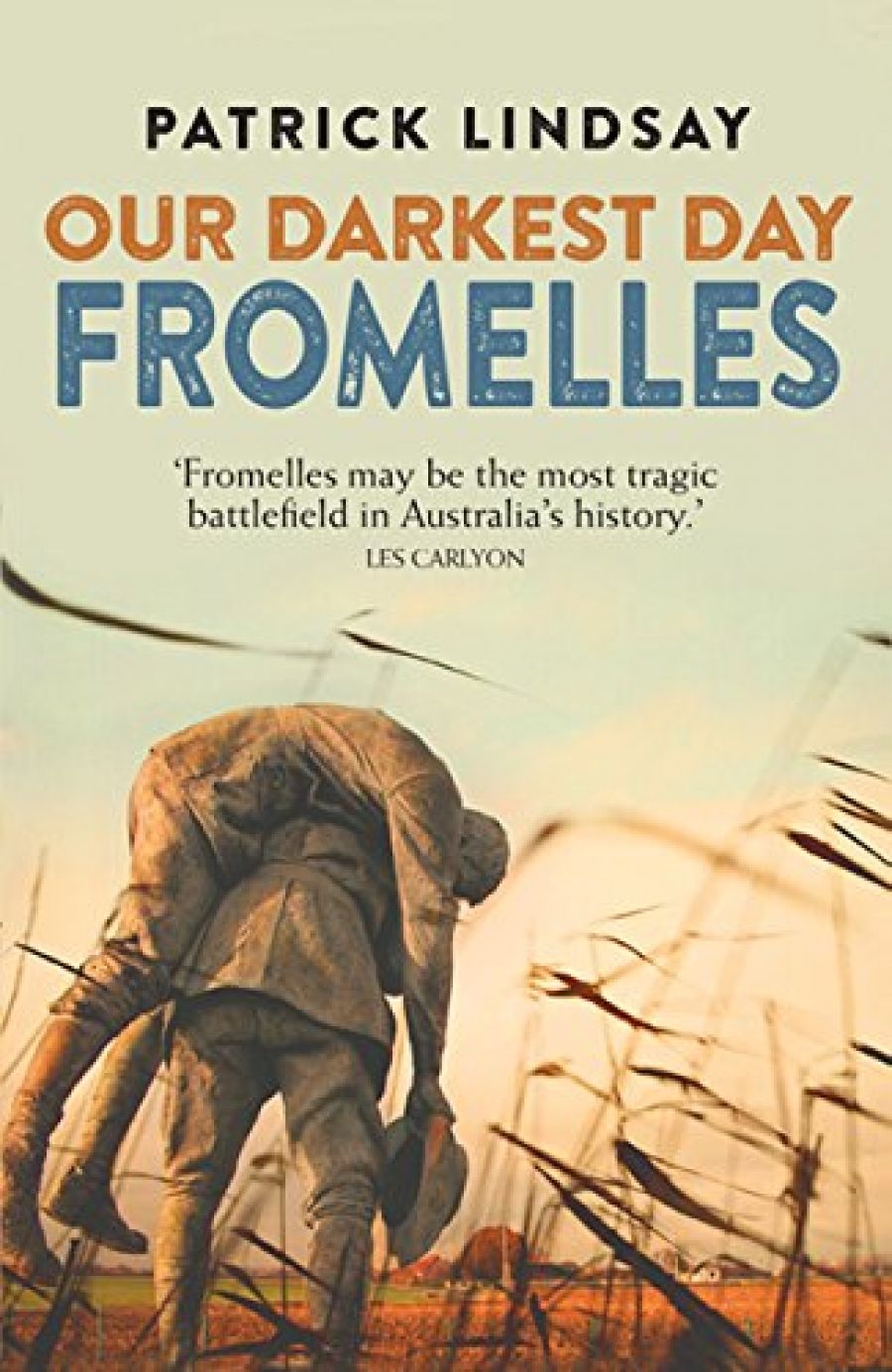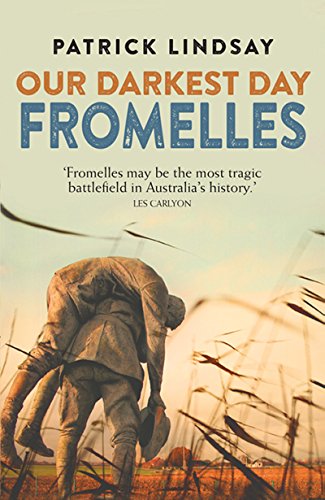
- Free Article: No
- Contents Category: Military History
- Custom Article Title: Rattling the consciences
- Review Article: Yes
- Article Title: Rattling the consciences
- Online Only: No
- Custom Highlight Text:
Ninety years after the Great War, the bones of those who died are still rattling the consciences of succeeding generations. Two years ago, there were frantic diplomatic exchanges between Australia and Turkey as the possibility emerged that the remains of Anzacs may have been disturbed as a result of road widening – ironically, to enable contemporary pilgrims to ‘pay their respects’ to those very bones. A complex bureaucratic tug-of-war has also been simmering over the whereabouts of the bones of approximately 170 Australians who died behind German lines at the battle of Fromelles on 19–20 July 1916.
- Book 1 Title: Fromelles
- Book 1 Biblio: Hardie Grant Books, $45 hb, 407 pp, 9781740665117
- Book 1 Cover Small (400 x 600):

- Book 1 Cover (800 x 1200):

Lindsay’s book is split into halves, each of which has its merits and deficiencies. After a short prologue, the first half of the book provides an account of the battle, including a potted history of the events of 1914–16, liberally salted with diary accounts and photographs to add personal immediacy. There is a clear benefit in providing some historical context of the battle – including references to one Corporal Hitler who served in the German Army at Fromelles – but Lindsay’s 170 pages stretch the limits of that benefit, especially given his approach to the material.
Like so many writers before him, Lindsay is defeated by the rhetorical demands of writing about the scale of death in the Great War. Everything is either ‘huge’ or ‘massive’. There are massive projectiles, massive blockhouses, massive rail transport and massive readjustment. There are massive forces, massive battles, massive artillery bombardments and of course, massive casualties. That’s only a small sample of Lindsay’s massive use of ‘massive’. Then there are the worn-out metaphors, such as the ‘irresistible hail of lead’ and ‘hail of steel’, and the soldiers who are by turns heroic, brave and inevitably gallant. First, there is the ‘gallant Cass’, then Lt. Chinner chips in with some ‘gallant defensive work’, and when we read that ‘the gallant Arblaster fell, mortally wounded’, we know we are in the realm of sentimental cliché.
These stylistic faults aside, Lindsay also struggles with where to pitch his account of the battle. It is certainly not military history; the use of sources is completely non-discursive, and while there are plenty of quotations, there are no references of any kind. There is, however, a sense of trying to bring Fromelles into public memory alongside more famous names such as Gallipoli, Pozières, and Villers-Bretonneux. Recently, Les Carlyon complained that the name Fromelles ‘refuses to lodge in the Australian consciousness’. Yet there have been a whole series of books published in the past few years on this battle, loudly proclaiming its name, including Robin Corfield’s Don’t Forget Me Cobber (2000), Peter Pedersen’s Fromelles (2004) and Paul Cobb’s Fromelles (2007). Add to that Carlyon’s work in The Great War (2006) and the countless battlefield guides being published, and Lindsay’s efforts seem like so much extra Flanders mud to wade through for no new insights and little gain.
It is the second half of the book that contains the real story, detailing the extraordinary efforts of Englezos to track down the graves of the lost 170 Australians. Born in Salonika in 1953, Englezos was just one year old when his family emigrated from Greece to a new life in Australia. He developed an interest in the Great War at a young age, and established a particular affinity with the 15th Brigade of the Australian Imperial Force, who fought at Gallipoli and subsequently at Fromelles. It was in 2002, on a visit to the VC Corner Cemetery at Fromelles, that he became aware of the number of missing bodies from the battle. As Lindsay writes, ‘A growing feeling welled up inside him. These missing Diggers were waiting for him to find them.’
Lambis drew a network of like-minded amateurs around him, and together they started their research. Anyone who has done archival research knows the mix of excitement and frustration this sort of work entails, but Englezos had a few lucky breaks, gleaning tantalising information from the records of the International Red Cross, as well as German Army archives that spoke of mass grave pits dug for ‘English’ soldiers. The real breakthrough came in studying aerial survey photographs carried out on the area during the war and discovering what looked like burial pits.
The frustration came when Englezos took his findings to the Australian Army and Department of Veterans’ Affairs. He found their response less than enthusiastic, but following the prodding of some press articles and some words in parliament, the Defence Department decided to assemble a panel to assess Englezos’s claims in June 2005. They ultimately commissioned John Williams to investigate the supposed burial pits, but his report largely dismissed Englezos’s ideas.
Lindsay is careful about what he says about all this. While it is clear where his feelings lie, he leaves it to his dramatis personae to criticise Williams and the eminent panel for their decisions. This is good policy. The problem is that Lindsay tries too hard to instil a sense of drama into this rather technical and complicated narrative. So, for example, he tells the story of the presentation to the panel as set-piece, but is reduced to details such as ‘with a click of the mouse’. This is a pity because, for the most part, Lindsay controls the complex events and characters with great clarity and poise.
The intrigue deepens with the arrival of Chris Bryett, a Sydney lawyer who took it upon himself to find the missing bodies with or without the help or approval of the Australian Government. He even assembled his own archaeological team and convinced the town authorities at Fromelles to allow him to commence surveying the relevant ground. At this point, the Australian government finally stepped in and took over, appointing its own archaeologist, the redoubtable Tony Pollard of Two Men in a Trench fame, to conduct a non-invasive examination of the site. In May 2007 Pollard’s team found evidence that convinced them that pits had indeed been used as mass graves and that further investigations involving digging should be carried out.
And that is where the story ends. The real truth lies waiting for the European summer of 2008 to determine if there are any Australian bodies at the site. It seems strange that Lindsay’s book could not have waited until then, to finish with a conclusive ending. As it is, it’s like a horse race that stops with who’s in front at the final bend. There is also the issue of critical debate. In a belated appendix, Lindsay acknowledges that Dr Pollard’s findings have been seriously called into question by a range of experts.
Finally, the question that haunts this whole book is what purpose is being served by digging up the ground to find old bones. One moment the population is in hysterics that relics have been disturbed at Gallipoli; the next, the popular press are screeching at authorities to exhume some apparently lost diggers. Ultimately, Lindsay’s focus on sentiment and mystery clouds the more important critical debate that is raised by Englezos’s passionate obsession.


Comments powered by CComment